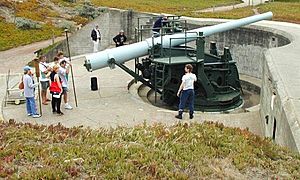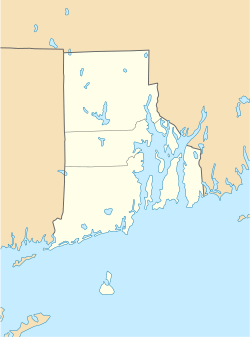Fort Kearny (Rhode Island) facts for kids
Quick facts for kids Fort Kearny |
|
|---|---|
| Part of Harbor Defenses of Narragansett Bay | |
| Saunderstown, Narragansett, Rhode Island | |

A 6-inch gun like those at Fort Kearny. This one is at Battery Chamberlin in San Francisco.
|
|
|
Location in Rhode Island
|
|
| Coordinates | 41°29′26″N 71°25′22″W / 41.49056°N 71.42278°W |
| Type | Coastal Defense, later POW camp |
| Site information | |
| Owner | University of Rhode Island |
| Controlled by | University of Rhode Island |
| Condition | partly re-used, partly built on |
| Site history | |
| Built | 1908 |
| Built by | United States Army |
| In use | 1908-1946 |
| Battles/wars | World War II |
Fort Kearny was a special fort built to protect the coast near Saunderstown and Narragansett, Rhode Island. It was active from 1901 to 1943. Later, in 1945, it became a camp for German prisoners during World War II. Today, this historic site is the Narragansett Bay Campus of the University of Rhode Island. You might also see its name spelled as Fort Kearney.
Contents
Building and Protecting the Coast
Fort Kearny was built between 1904 and 1908. It was part of a big plan called the Endicott Program. This program aimed to build strong forts along the American coast. Fort Kearny was named after Major General Philip Kearny, a hero from the American Civil War.
The fort's main job was to protect the West Passage of Narragansett Bay. It worked with other forts like Fort Getty in Jamestown and Fort Greble on Dutch Island.
What Guns Did Fort Kearny Have?
Fort Kearny had several powerful guns.
- It had six large 6-inch M1905 guns. These were on special mounts called disappearing carriages. These mounts could hide the gun after it fired. Four of these guns were in a section called Battery French. The other two were in Battery Cram.
- There were also two smaller 3-inch M1903 guns in Battery Armistead.
These gun batteries were named after important military figures. Battery French was named for William H. French, a Civil War general. Battery Cram was named for Thomas J. Cram, an engineer from the Civil War. Battery Armistead was named for Captain Lewis G. A. Armistead, who died in the War of 1812.
Fort Kearny During the World Wars
During World War I, some of Fort Kearny's guns were removed in 1917. They were planned to be sent to France to help on the Western Front. However, the war ended with the Armistice before these guns were used in battle. They were never returned to Fort Kearny.
In World War II, the coastal defenses were updated. New, stronger forts like Fort Church and Fort Greene became the main defense points. Because of these new forts, Fort Kearny's guns were no longer needed.
- In 1942, the 3-inch guns from Battery Armistead were moved to Fort Varnum.
- By 1943, Fort Kearny's last two guns at Battery Cram were taken apart and recycled.
A Camp for Prisoners
After its guns were removed, Fort Kearny found a new purpose. In February 1945, it became a prisoner-of-war camp for German soldiers captured during World War II.
This camp was special because it was a center for a program to teach German prisoners about democratic ideas. One important part of this program was a German-language newspaper called Der Ruf (The Call). This newspaper helped share new ideas with the prisoners.
Fort Kearny Today
Today, Fort Kearny is no longer a military fort. It is now the Narragansett Bay Campus of the University of Rhode Island.
Some parts of the old fort have been changed for new uses:
- A small nuclear research reactor has been built on top of where Battery French used to be.
- Battery Cram and Battery Armistead have been updated and are now used as office spaces.


